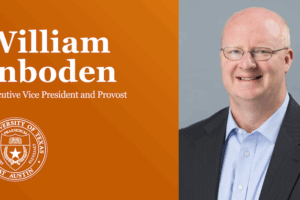AUSTIN, Texas—A model for a wireless device that would transmit libraries-full of information each second is being designed by an electrical and computer engineering team at The University of Texas at Austin with $909,000 from the U.S. Army Research Laboratory.
“Imagine if you could beam entire contents of manuals or entire hard drives worth of information over the air,” said lead investigator Theodore S. Rappaport. “The idea is to make lighter-weight, much more rugged and less expensive devices than laptops that allow for transmitting massive amounts of content.”

|
|
Dr. Ted Rappaport, professor of electrical and computer engineering, was awarded $909,000 in a cooperative agreement with the U.S. Army Research Laboratory to design a model for a wireless device that would transmit libraries-full of information each second. These massively broadband wireless devices would operate at a radio frequency of 60 gigahertz.
|
| Photo: Jennie Trower |
For decades, communication companies have been investigating another approach, called Ultra Wideband (UWB) technologies for short-range wireless data transmissions. Those technologies will form the guts of wireless devices that transmit a billion bits (a gigabit) of information per second over short distances in homes and offices. Rappaport, holder of the William and Bettye Nowlin Chair in Engineering, plans to use the funds received in a cooperative agreement with the Army in mid-July to develop devices that can transmit much faster than UWB for use between military personnel in a combat unit, co-workers in an office suite or others in close proximity.
Unlike UWB-based devices, these massively broadband wireless devices would operate at a radio frequency of 60 gigahertz. That part of the electromagnetic spectrum has already been set aside for future wireless use by governments in Europe, Japan and the United States to service global-communication needs.
The Army funding will allow Rappaport, who directs the university’s Wireless Networking and Communications Group (WNCG), to purchase expensive radio-frequency test equipment, wafer-probe stations and computer software for designing and testing components of the wireless devices.
“This radio frequency is so high, there really aren’t well understood design rules to go by,” he said. “It’s an unknown how different electrical elements will perform when they’re fabricated, so we have to learn by simulation, fabrication, and by trial and error how to design for these higher frequencies with silicon chips.”
New, tiny radio antennas and other components will also be needed to handle this radio frequency. The funding, which will be used in upcoming months, will also provide partial salaries for Rappaport, five other faculty and a research associate in the Department of Electrical and Computer Engineering who will install the new equipment for designing device components. And it will be used to purchase novel equipment to test the radio-signal capabilities of the prototype device, expected to be designed in about 18 months.
The main components of the prototype will be a combination radio-signal transmitter and receiver (transceiver), and the integrated circuits for handling storage and retrieval of information. If the miniaturization of semiconductors proceeds as expected, Rappaport envisions an as-yet-to-be-named semiconductor manufacturer building the first prototype in about five years, using microprocessors with components as small as 42 nanometers or 65 nanometers.
“This massively broadband device will be quite small—smaller than your fingernail,” says Rappaport.
And cheap, if all goes as planned. The anticipated cost is $5 for a single chip and integrated transceiver, with the ability to transmit data a distance of about 5 meters (16.4 feet).
Rappaport compares the final product’s potential to that of electronic notepads that are readily accessible on someone’s computer desktop, but with extraordinary content-carrying capacity.
“These wireless devices will be able to transmit things at such a fast data rate, it’ll virtually be like you’re carrying your entire life’s memory content from your home and office with you,” he said.
Each 60 gigahertz wireless device could also be a part of a network of such devices connected through mobile equipment.
In designing the prototype, Rappaport will draw on the expertise of the following grant participants: WNCG Associate Director Gustavo de Veciana, an expert on designing telecommunication networks, and holder of the General Motors Foundation Centennial Teaching Fellowship in Electrical Engineering; Research Associate Lawrence Ragan, an expert on radio frequency integrated circuits; Sanjay Banerjee, an expert on designing computer memory cells and holder of the Cockrell Family Regents Chair in Engineering No. 4; and Assistant Professors Jeff Andrews and Robert Heath Jr., who have expertise in multiple-access communications and antennas.
To learn about other faculty affiliated with the study and added details, visit the Wireless Networking and Communications Group Bits and Bytes Web site.
For more information contact: Becky Rische, College of Engineering, 512-471-7272.



